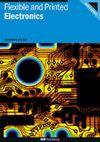低熔融温度下嵌入聚合物衬底的转移印刷柔性电路的抗疲劳性能改进
IF 3.2
4区 工程技术
Q3 MATERIALS SCIENCE, MULTIDISCIPLINARY
引用次数: 0
摘要
从可穿戴电子产品到太阳能电池,柔性电子产品在一系列领域的应用引起了人们的极大兴趣和重视。虽然近年来印刷柔性电子器件的分辨率不断提高,但仍然存在机械疲劳和衬底成本问题,限制了此类器件的使用,导致成本和废物的增加。在这里,我们提出了一种新方法,通过在将电子元件转移到低成本聚合物基板之前将电子元件烧结,使其保持嵌入,从而将印刷柔性电子元件的抗疲劳性提高约40倍。该方法通过使用气溶胶喷射打印机打印纳米银墨水的电路进行了演示,并且可以适用于多种不同的金属墨水。同时,该方法可用于将印刷电路转移到具有低熔融温度的聚合物中,而不需要墨水固化所需的有害的高烧结温度。本文章由计算机程序翻译,如有差异,请以英文原文为准。
Improved fatigue resistance in transfer-printed flexible circuits embedded in polymer substrates with low melting temperatures
Flexible electronics are of great interest and importance due to their applications in a range of fields, from wearable electronics to solar cells. Whilst resolutions of printed flexible electronics have been improving in recent years, there remain problems with mechanical fatigue and substrate cost, curtailing the use of such devices and resulting in increased cost and waste products. Here we present a novel method for improving the fatigue resistance of printed flexible electronics by a factor of ∼40 by sintering the electronics prior to transferring them into low-cost polymer substrates, such that they remain embedded. This method is demonstrated using circuits printed using silver nanoparticulate ink with an aerosol jet printer, and could be applicable to multiple different metallic inks. At the same time, this method can be used to transfer print circuits into polymers with low melting temperatures, without the need for otherwise detrimentally high sintering temperatures required for ink curing.
求助全文
通过发布文献求助,成功后即可免费获取论文全文。
去求助
来源期刊

Flexible and Printed Electronics
MATERIALS SCIENCE, MULTIDISCIPLINARY-
CiteScore
4.80
自引率
9.70%
发文量
101
期刊介绍:
Flexible and Printed Electronics is a multidisciplinary journal publishing cutting edge research articles on electronics that can be either flexible, plastic, stretchable, conformable or printed. Research related to electronic materials, manufacturing techniques, components or systems which meets any one (or more) of the above criteria is suitable for publication in the journal. Subjects included in the journal range from flexible materials and printing techniques, design or modelling of electrical systems and components, advanced fabrication methods and bioelectronics, to the properties of devices and end user applications.
 求助内容:
求助内容: 应助结果提醒方式:
应助结果提醒方式:


